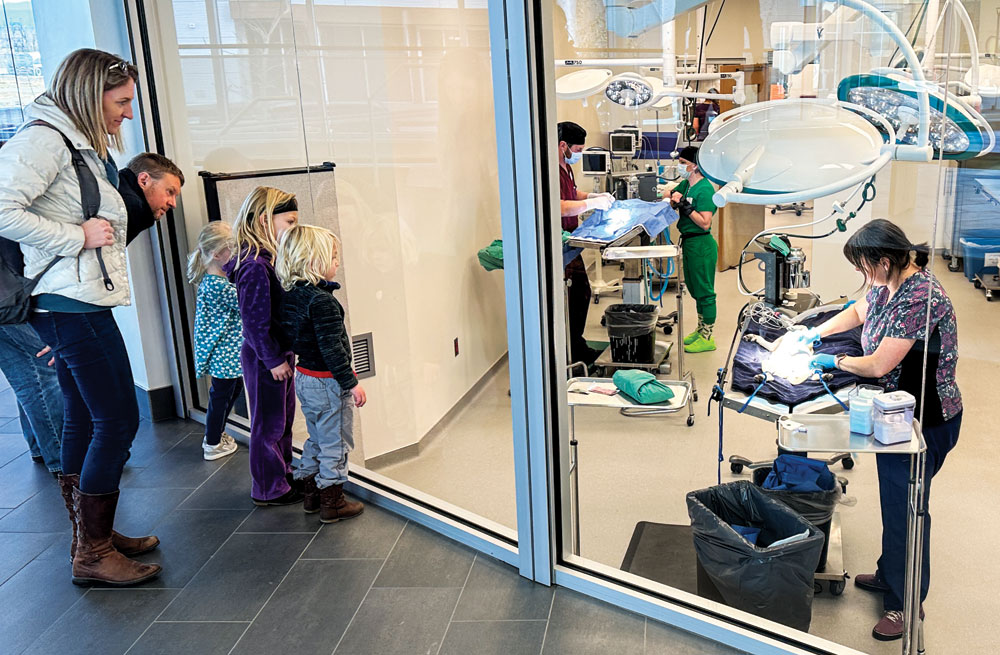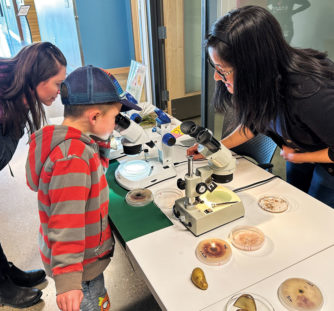
Colorado State University Professor David G. Holm helped lead a workshop at a recent Second Saturday event at the CSU Spur campus in north Denver. Here visitors are learning about ways scientists are breeding new potato varieties so they have a longer shelf life.
On a recent Saturday at the Terra building on the CSU Spur campus in north Denver, it was “potato” day. Children and teens were talking with scientists about creating improved potato varieties. Others were cooking with spuds in a demonstration kitchen. Still others were looking at potato diseases under a microscope. It is all part of CSU’s mission to inspire young people to consider careers in science.

The Denver Dumb Friends League Veterinary Hospital at CSU Spur serves low-income clients. The large observation windows in the Vida Building offer a chance
for visitors to watch and ask questions of the veterinarians and technicians as they perform procedures.
Terra (which is Latin for “earth”) opened in June and concentrates on agriculture. “We want to introduce young people to all areas of the food system. From farming to the transportation of food, to turning it into a food product, and to actually cooking with it,” says Jocelyn Hittle, associate vice chancellor for the CSU Spur Campus. Terra features a rooftop garden and greenhouse, labs where researchers are working on improving crops, food labs where entrepreneurs develop new food products, and kitchens where recipes are tested and nutrition and cooking classes are offered. The whole idea is to allow young people to watch scientists and other professionals in action, with the hope of sparking curiosity about career possibilities.

The new buildings include whimsical architectural elements, like this “avocado window” near the entrance to the Terra Building.
Terra, like all of the CSU Spur buildings, is free and open to the public Monday through Friday, and it often hosts school field trips as well. So far, 3,500 students and teachers have toured Terra. For families, the best time to visit is during the Second Saturday program, which every month features a different theme for demonstrations, activities, and local food trucks.

Chef Vince Armada of Potatoes USA, a Denver-based marketing and research group, teaches young visitors how to make a potato dish.
In addition to Terra, the CSU Spur campus includes Vida (Spanish for “life”), a facility that focuses on the connection between animal and human health. It houses a veterinary clinic operated by the Denver Dumb Friends League that provides low-cost services for low-income pet owners. With large window-views of its operating theater, the clinic allows visitors to watch and ask questions as veterinarians operate on cats and dogs. Children can also use a “play clinic” to pretend to treat stuffed animals, and visitors can use a virtual reality room to have a 3-D experience while exploring animal or human bodies.

Young visitors to the Vida Building try their hand at being veterinarians by treating stuffed animals in the mock veterinary exam room.
Terra is also home to the Temple Grandin Equine Center, which provides equine-assisted therapy for people who face a broad range of physical, emotional, and mental challenges. Eventually, an equine sports medicine clinic will open and let the public watch as horses go through physical therapy—including sessions on an underwater treadmill.
Vida opened last January and has hosted 18,000 visitors. Kathryn Venzor, director of education at the CSU Spur says the most popular attraction is the vet clinic. “The kids can see cats and dogs in surgery and ask the veterinarians questions. The students really get very engaged and enthralled with it all.”
Venzor says CSU has deliberately reached out to low-income and under-represented schools to schedule field trips and offer reimbursements for busing costs. “Our big goal is to increase the workforce in the STEM fields—not only increase in numbers but increase in diversity. And the way to do that is to ensure we have more diversity coming through our doors.”

Second Saturday demonstrations are a great way for families to experience what CSU Spur has to offer. Here children learn about how an auger works.
The CSU Spur campus is located at the National Western Center and hopes to attract some of the 10,000 students who visit the National Western Stock Show every year. This year on Jan. 6, the day before the stock show begins, CSU will officially open its third and final new building named Hydro (the Greek word for “water”). Denver Water is opening a huge water compliance lab on the third floor where scientists are expected to conduct more than 200,000 tests each year for water quality. There will also be labs for researchers and students at CSU.
Hydro will feature exhibits that explain the connections between water and health and that offer tips on water conservation. The education staff at Hydro is currently in the process of ordering child-sized waders so students will have the chance to study the nearby Platte River. “There will be a nice safe path to the river where our educators will take students to collect water samples, look for indicators of water quality, and compare the water samples to drinking water,” says Venzor. “We want them to understand why water is so important and get them to become good stewards of water.”
Hydro will also house a café that utilizes food grown on the roof of the Terra building, and a 3,500-seat auditorium that can be used for lectures or performances by CSU and the surrounding Globeville and Elyria-Swansea community.

Inspiring careers in science is a major goal of CSU Spur. These visitors were learning about plant diseases by examining them under microscopes.
Another goal of the CSU Spur is to serve as an “anchor institution” for the neighborhood. Sarah Miley, who is in charge of community engagement, says that CSU hopes to use its vast purchasing abilities and hiring power to help with community wealth building and local community impact. “We are building relationships with the businesses in the community so that when people host an event at our buildings, they can hire local caterers or local bands,” says Miley. “Often big institutions like a state university can have bureaucratic systems in place that can be barriers for small, minority-owned businesses. We’re trying to break down those barriers.”
CSU Spur hopes to grow community partnerships in other areas too. CSU botanists have given advice to residents about tree care, which corresponds with a recent tree-planting effort in the neighborhood. Local non-profits are encouraged to conduct workshops at the Spur. This summer, CSU Spur plans to launch four or five summer camps that will give priority to neighborhood children. And in the near future, the Terra facility hopes to offer cooking classes taught by local chefs.
Hittle says the work of the Spur is just getting started, and she encourages everyone to come visit—whether on a weekday or for a Second Saturday event.
“It’s hard to understand what CSU Spur is until you come here and see it in action and really see the magic of kids getting a chance to talk to these scientists and professionals at work. And also the magic of those professionals getting to describe to young people what they do. It really energizes everyone to be in this space together.”
For more information about scheduling field trips or attending a Second Saturday event, visit csuspur.org.
Front Porch photos by Christie Gosch


Great